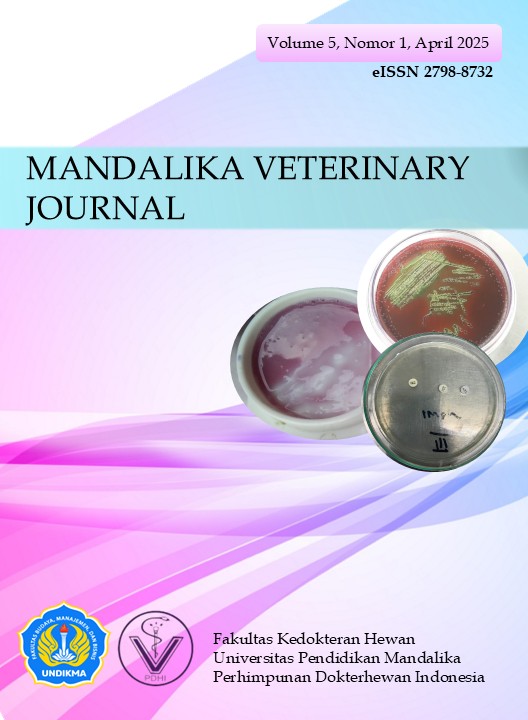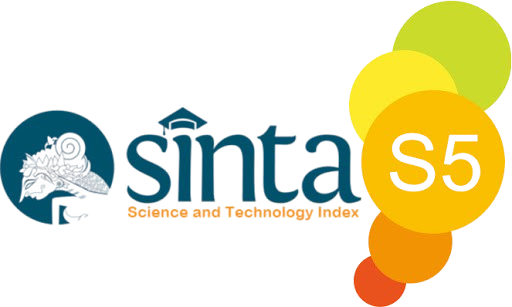Deteksi Caplak Amblyomma sp pada Ular Sanca Bodo (Phyton bivittatus) Di Komunitas Exotic Pet Lovers Lombok Timur
DOI:
https://doi.org/10.33394/mvj.v5i1.15200Keywords:
Caplak, Python bivittatus, Amblyomma sp., Komunitas Exotic Pet Lovers.Abstract
Komunitas Exotic Pet Lovers Lombok salah satu komunitas tekenal di Lombok Nusa Tenggara Barat. Salah satu hewan eksotiknya Ular Sanca Bodo (Phython bivittatus). Ular sanca bodo (Python bivittatus) memiliki pola warna yang menarik, tidak berbisa, dan kemampuan adaptasi yang baik. Dalam manajemen pemeliharaan tidak memungkinkan tekena ektoparasit caplak yang dapat merusak pola warna ular tersebut. Penelitian ini bertujuan untuk mendeteksi ektoparasit caplak pada ular sanca bodo (Python bivittatus) di Komunitas Exotic Pet Lovers Lombok yang merupakan komunitas dengan anggota yang lebih dari 20 orang. Besaran sampel yang digunakan adalah accidental sampling dengan jumlah sampel 3 ekor ular piton sanca bodo. Pemeriksaan ektoparasit dilakukan dengan metode natif dimana parasit diambil langsung dari tubuh ular dengan hati-hati menggunakan pinset dan ditempatkan pada kaca objek. Berdasarkan hasil penelitian deteksi ektoparasit pada ular sanca bodo (Python bivittatus) yang dipelihara oleh Komunitas Exotic Pet Lovers Lombok Timur dari tiga sampel ular yang diperiksa, satu ekor ular terdeteksi caplak dari jenis Amblyomma sp.
References
Corn, j. l., Mertins, J. W., Hanson, B., & Snow, S. (2011). First reports of ectoparasites collected from wild-caught exotic reptiles in Florida. Journal of Medical Entomology, 48(1), 94–100.
Dini, S. K., Triakoso, N., Saputro, A. L., & Yudhana, A. (2022). Capillaria spp. In a Reticulated Python (Python reticulatus) in Banyuwangi Reptile Community. Jurnal Medik Veteriner, 5(1), 119–123.
Dwiyani, N. P., Setiati, N., & Widiyaningrum, P. (2014). Ektoparasit Pada Ordo Artiodactyla di Taman Margasatwa Semarang. Unnes Journal of Life Science 3, 3(2), 124–129. Ektoparasit
Fransiska Okta Zania, Audina Putri Geraldine, Citra Kurnia Putri, Ryanka Edila, & Aditya Yudhana. (2022). Laporan Pertama Kasus Infestasi Spinturnix spp. Pada Kelelawar Pemakan Buah (Rousettus spp.). Media Kedokteran Hewan, 33(3), 233–243.
Groot, K. De. (2018). No itle. World Development, 1(1), 1–15.
Halaman, J., Pers, P. D. I., & Colubridae, R. (2013). Pasal di pers. 2–6.
Hasson, R. H., & Al-Zubaidi, H. H. (2015). The acaricidal effect of clove leaf plant extract Eugenia caryophyllus against Argas spp. Soft ticks in Iraq. International Journal of Advanced Research, 3(9), 257–262.
Hoffmann, 2009. (2009). No Title. Acta Universitatis Agriculturae et Silviculturae Mendelianae Brunensis, 53(9), 1689–1699.
Hunter, m. e., Johnson, n. a., Smith, b. j., Davis, m. c., Butterfield, J. S. S., Snow, r. w., & hart, k. m. (2018). Cytonuclear discordance in the Florida Everglades invasive Burmese python ( Python bivittatu s ) population reveals possible hybridization with the Indian python ( P . Molurus ). August 2017, 9034–9047.
Integratif, T. A., & Ixodid, P. (2022). Taktik Alternatif Integratif untuk Pengendalian Ixodid.
Jantung, G., Jacobson, P. E. R., Homer, B., Adams, W., & Jurnal, S. (2009). Machine Translated by Google Diterbitkan oleh : American Association of Zoo Veterinarians Machine Translated by Google Endokarditis Dan Gagal Jantung Kongestif Pada A Python Burma ( Python Molurus Bivittatus ).
Joshi, R. (2015). Perluasan Jangkauan dan Distribusi Geografis Rekor untuk Python Burma , Piton bivittatus Kuhl 1820 ( Reptilia : Pythonidae ) di India Barat Laut. 15, 102–105.
Katmono, W. D., Prayoga, S. F., Oktaviana, V., & Fikri, F. (2019). Case Report: Amblyomma sp. On Sanca Kembang Snake (Python reticulatus) in Banyuwangi Reptile Community. Jurnal Medik Veteriner, 2(2), 140–144.
Kedokteran, F., Universitas, H., & Azaria, A. (2020). No Title. 72–78.
Khaula, Kamal, S., & Isfanda. (2020). Karakteristik Serangga Ordo Pthireptera (Kutu) Pada Kambing (Capra aegagrus hircus) Dan Domba (Ovis aries) Aceh Besar. Prosiding Seminar Nasional Biotik, 39–42.
Krey, K. (2010). Ektoparasit Acarina Pada Kulit Sisik Ular Putih (Micropecis Ikaheka) Dari Manokwari. Jurnal Natural, 9(1).
Lv, J., De Marco, M. D. M. F., Goharriz, H., Phipps, L. P., mcelhinney, L. M., Hernández-Triana, L. M., Wu, S., Lin, X., Fooks, A. R., & Johnson, N. (2018). Detection of tick-borne bacteria and babesia with zoonotic potential in Argas (Carios) vespertilionis (Latreille, 1802) ticks from British bats. Scientific Reports, 8(1), 1–9.
Martha Puri, K., Mairawita Laboratorium Taksonomi Hewan, dan, & Biologi, J. (2014). Jenis-Jenis dan Prevalensi Ektoparasit Pada Anjing Peliharaan Ectoparasite Species and Their Prevalence on Pet Dogs. Jurnal Biologi Universitas Andalas (J. Bio. UA.), 3(3), 183–187.
Metode, B. D. A. N. (1974). Siklus hidup Amblyomma hebraeum Koch , 1844 (Acarina: Ixodidae). 37(2), 357–367.
Morand, S., & Krasnov, B. R. (2006). Micromammals and Macroparasites. In Micromammals and Macroparasites.
Aryazura, M. F., Riandi, L. V., Fahrimal, Y., & Aisyah, S. (2024). Identifikasi Parasit Darah Dan Ektoparasit Pada Iguana ( Iguana iguana ) Yang Dipelihara Di Komunitas Iguana Banda Aceh Identification of Blood Parasites and Ectoparasites in Iguana ( Iguana Iguana ) Petted in Banda Aceh Iguana Community. 8(3), 105–112.
Mulenga, A., Khumthong, R., Chalaire, K. C., Strey, O., & Teel, P. (2008). Molecular and biological characterization of the Amblyomma americanum organic anion transporter polypeptide. Journal of Experimental Biology, 211(21), 3401–3408.
Natusch, D. J. D., Lyons, J. A., Dubey, S., & Shine, R. (2018). Ticks on snakes: The ecological correlates of ectoparasite infection in free-ranging snakes in tropical Australia. Austral Ecology, 43(5), 534–546.
Portugaliza, H. P., & Bagot, M. A. (2015). Berbagai spesies kutu ( Phthiraptera ), kutu ( Siphonaptera ) dan kutu ( Ixodida) dikumpulkan dari ternak , unggas , reptil dan hewan pendamping di Pulau Leyte , Filipina. 27(8), 1–10.
Pratama, T. (2022). Aplikasi Pembelajaran Hewan Reptil Berbasis Augmented Reality. Jurnal Informatika Dan Rekayasa Perangkat Lunak, 3(1), 73–76.
Puadi, E. F. W. (2017). Analisis Peningkatan Kemampuan Koneksi Matematis Mahasiswa Ptik Melalui Pembelajaran Berbasis Masalah. 5.
Radulović, Ž. M., Kim, T. K., Porter, L. M., Sze, S. H., Lewis, L., & Mulenga, A. (2014). Journal of losses and solutions infected with amblyomma ticks. BMC Genomics, 15(1), 1–24.
Ristiyanto, Mulyono A., Agustina M., Yuliadi B., Muhidin M. (2016). Indeks keragaman ektoparasit in roof rat r. Tanezumi (Temminck, 1844) and polynesian rat r. Exulans (Peal, 1848) in plague area. Jurnal Vektora, 1(2), 73–84.
Sciences, B. (2004). Technical Appendix D8 Pathogenic Micro-organism Threats to the.
Smit, A., Jose, U., Huber, K., Makepeace, B., & Neves, L. (2024). Variasi Intra dan Interspesifik Kutu Amblyomma dari Afrika Selatan. 1–26.
Supriatman, R. D. (2023). Aplikasi Penentuan Hasil Persilangan Ular Phyton Molurus Bivittatus Berbasis Android. Jurnal Sistem Informasi Galuh, 1(1), 1–7.
Whitney, N. M., White, C. F., Smith, B. J., Cherkiss, M. S., Mazzotti, F. J., & Hart, K. M. (2021). Accelerometry to study fine-scale activity of invasive Burmese pythons (Python bivittatus) in the wild. Animal Biotelemetry, 9(1), 1–13.
Zania F.O., Geraldine A.P., Putri C.K, Edila R, Yudhana A. (2022). Laporan Pertama Kasus Infestasi Spinturnix spp. Pada Kelelawar Pemakan Buah (Rousettus spp.). Media Kedokteran Hewan, 33(3), 233–243.
Downloads
Published
How to Cite
Issue
Section
Citation Check
License
Authors who publish with this journal agree to the following terms:
- Authors retain copyright and grant the journal right of first publication with the work simultaneously licensed under a Creative Commons Attribution License that allows others to share the work with an acknowledgement of the work's authorship and initial publication in this journal.
- Authors are able to enter into separate, additional contractual arrangements for the non-exclusive distribution of the journal's published version of the work (e.g., post it to an institutional repository or publish it in a book), with an acknowledgement of its initial publication in this journal.
- Authors are permitted and encouraged to post their work online (e.g., in institutional repositories or on their website) prior to and during the submission process, as it can lead to productive exchanges, as well as earlier and greater citation of published work (See The Effect of Open Access).





